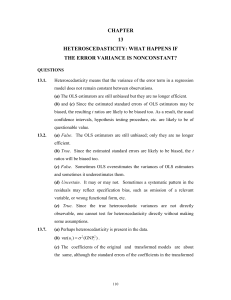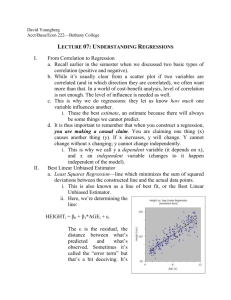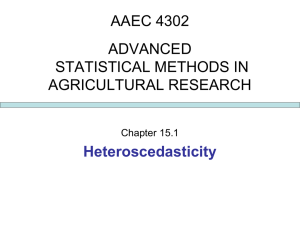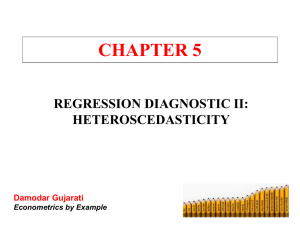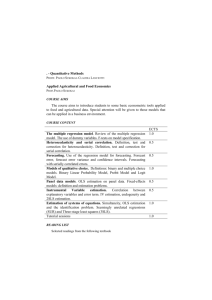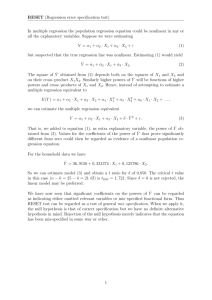Study guide chapter 7 (EC220)
advertisement
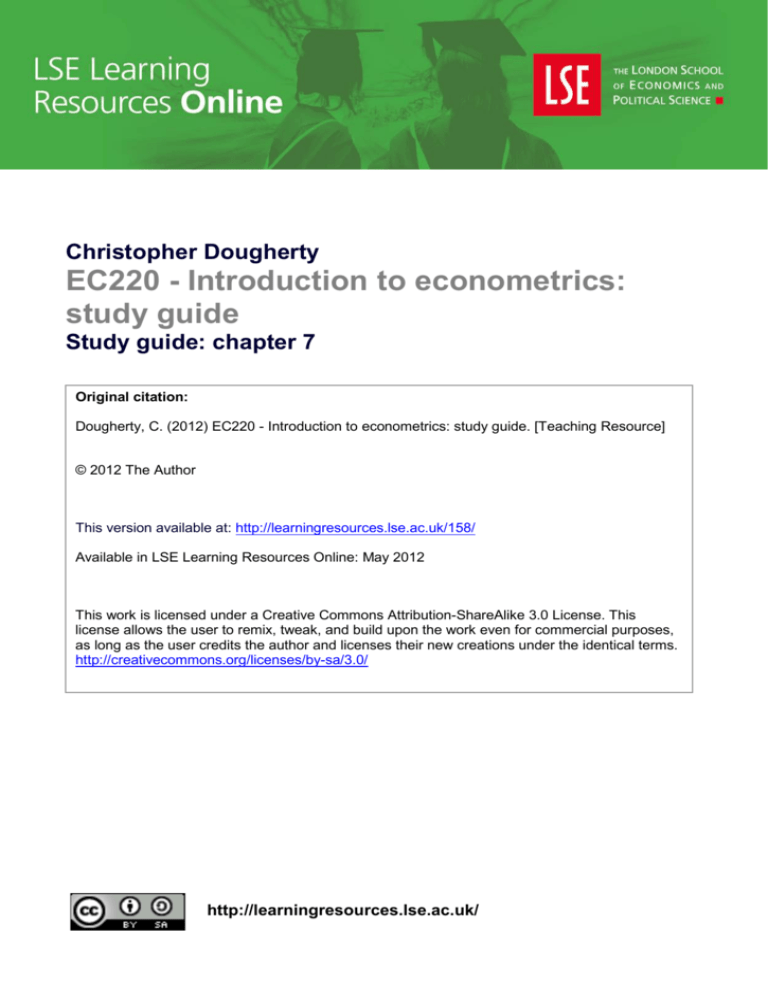
Christopher Dougherty EC220 - Introduction to econometrics: study guide Study guide: chapter 7 Original citation: Dougherty, C. (2012) EC220 - Introduction to econometrics: study guide. [Teaching Resource] © 2012 The Author This version available at: http://learningresources.lse.ac.uk/158/ Available in LSE Learning Resources Online: May 2012 This work is licensed under a Creative Commons Attribution-ShareAlike 3.0 License. This license allows the user to remix, tweak, and build upon the work even for commercial purposes, as long as the user credits the author and licenses their new creations under the identical terms. http://creativecommons.org/licenses/by-sa/3.0/ http://learningresources.lse.ac.uk/ Chapter 7 Heteroscedasticity Overview This chapter begins with a general discussion of homoscedasticity and heteroscedasticity: the meanings of the terms, the reasons why the distribution of a disturbance term may be subject to heteroscedasticity, and the consequences of the problem for OLS estimators. It continues by presenting several tests for heteroscedasticity and methods of alleviating the problem. It shows how apparent heteroscedasticty may be caused by model misspecification. It concludes with a description of the use of heteroscedasticity-consistent standard errors. Learning outcomes After working through the corresponding chapter in the text, studying the corresponding slideshows, and doing the starred exercises in the text and the additional exercises in this guide, you should be able to: explain the concepts of homoscedasticity and heteroscedasticity describe how the problem of heteroscedasticity may arise explain the consequences of heteroscedasticity for OLS estimators, their standard errors, and t and F tests perform the Goldfeld–Quandt test for heteroscedasticity perform the White test for heteroscedasticity explain how the problem of heteroscedasticity may be alleviated explain why a mathematical misspecification of the regression model may give rise to a problem of apparent heteroscedasticity explain the use of heteroscedasticity-consistent standard errors. Additional exercises A7.1 Is the disturbance term in your CES expenditure function heteroscedastic? Sort the data by EXPPC, regress CATPC on EXPPC and SIZE, and perform a Goldfeld–Quandt test to test for heteroscedasticity in the EXPPC dimension. Repeat using LGCATPC as the dependent variable. A7.2 The observations for the occupational schools (see Chapter 5 in the text) in the figure suggest that a simple linear regression of cost on number of students, restricted to the subsample of these schools, would be subject to heteroscedasticity. Download the data set from the heteroscedastic data sets folder on the website and use a Goldfeld–Quandt test to investigate whether this is the case. If the relationship is heteroscedastic, what could be done to alleviate the problem? April 2011 2 COST 600000 500000 400000 300000 200000 100000 0 0 200 400 600 Occupational schools 800 1000 1200 N Regular schools A7.3 A researcher hypothesizes that larger economies should be more self-sufficient than smaller ones and that M/G, the ratio of imports, M, to gross domestic product, G, should be negatively related to G: M 1 2 G u G with 2 < 0. Using data for a sample of 42 countries, with M and G both measured in US$ billion, he fits the regression (standard errors in parentheses): ^ M G = 0.37 – (0.03) R2 = 0.12 0.000086 G (1) (0.000036) M tends to have relatively G high variance when G is small. He also plots a scatter diagram for M and G, reproduced as Figure 2. Defining GSQ as the square of G, he regresses M on G and GSQ: He plots a scatter diagram, reproduced as Figure 1, and notices that the ratio M̂ = 7.27 + 0.30 G – 0.000049 GSQ (10.77) (0.03) (0.000009) R2 = 0.86 (2) Finally, he plots a scatter diagram for log M and log G, reproduced as Figure 3, and regresses log M on log G: ^ log M R2 = 0.78 = –0.14 + 0.80 log G (0.37) (0.07) (3) Having sorted the data by G, he tests for heteroscedasticity by regressing specifications (1) – (3) first for the 16 countries with smallest G, and then for the 16 countries with the greatest G. RSS1 and RSS2. the residual sums of squares for these regressions, are summarized in the table. Specification RSS1 RSS2 (1) 0.53 0.21 (2) 3178 71404 (3) 3.45 3.60 3 1.0 0.8 M/G 0.6 0.4 0.2 0.0 0 1000 2000 3000 4000 3000 4000 G Figure 1 600 500 M 400 300 200 100 0 0 1000 2000 G Figure 2 8 7 log M 6 5 4 3 2 1 3 4 5 6 log G Figure 3 7 8 9 4 ▪ ▪ ▪ ▪ ▪ ▪ Discuss whether (1) appears to be an acceptable specification, given the data in the table and Figure 1. Explain what the researcher hoped to achieve by running regression (2). Discuss whether (2) appears to be an acceptable specification, given the data in the table and Figure 2. Explain what the researcher hoped to achieve by running regression (3). Discuss whether (3) appears to be an acceptable specification, given the data in the table and Figure 3. What are your conclusions concerning the researcher's hypothesis? A7.4 A researcher has data on the number of children attending, N, and annual recurrent expenditure, EXP, measured in US dollars, for 50 nursery schools in a US city for 2006 and hypothesizes that the cost function is of the quadratic form EXP = 1 + 2N + 3NSQ + u where NSQ is the square of N, anticipating that economies of scale will cause 3 to be negative. He fits the following equation: EXˆP = 17,999 + (12,908) 1,060 N – 1.29 NSQ (133) (0.30) R2=0.74 (1) Suspecting that the regression was subject to heteroscedasticity, the researcher runs the regression twice more, first with the 19 schools with lowest enrolments, then with the 19 schools with the highest enrolments. The residual sums of squares in the two regressions are 8.0 million and 64.0 million, respectively. The researcher defines a new variable, EXPN, expenditure per student, as EXPN = EXP/N, and fits the equation ^ EXPN = 1,080 – 1.25 N + (90) (0.25) 16,114 NREC (6,000) R2=0.65 (2) where NREC = 1/N. He again runs regressions with the 19 smallest schools and the 19 largest schools and the residual sums of squares are 900,000 and 600,000. ▪ Perform a Goldfeld–Quandt test for heteroscedasticity on both of the regression specifications. ▪ Explain why the researcher ran the second regression. ▪ R2 is lower in regression (2) than in regression (1). Does this mean that regression (1) is preferable? A7.5 This is a continuation of Exercise A6.5. ▪ When the researcher presents her results at a seminar, one of the participants says that, since I and G and have been divided by Y, (2) is less likely to be subject to heteroscedasticity than (1). Evaluate this suggestion. A7.6 A researcher has data on annual household expenditure on food, F, and total annual household expenditure, E, both measured in dollars, for 400 households in the United States for 2010. The scatter plot for the data is shown as Figure 1. The basic model of the researcher is F 1 2 E u (1) where u is a disturbance term. The researcher suspects heteroscedasticity and performs a Goldfeld– Quandt test and a White test. For the Goldfeld–Quandt test, she sorts the data by size of E and fits the model for the subsample with the 150 smallest values of E and for the subsample with the 150 largest values. The residual sums of squares (RSS) for these regressions are shown in column (1) of the table. She also fits the regression for the entire sample, saves the residuals, and then fits an auxiliary regression of the squared residuals on E and its square. R2 for this regression is also shown in column (1) in the table. She performs parallel tests of heteroscedasticity for two alternative models: 5 1 F E 1 2 v ` A A A (2) log F 1 2 log E w (3) A is household size in terms of equivalent adults, giving each adult a weight of 1 and each child a weight of 0.7. The scatter plot for F / A and E / A is shown as Figure 2, and that for log F and log E as Figure 5.3. The data for the heteroscedasticity tests for models (2) and (3) are shown in columns (2) and (3) of the table. Specification Goldfeld–Quandt test RSS smallest 150 RSS largest 150 White test R2 from auxiliary regression ▪ ▪ 200 million 820 million 0.160 (2) (3) 40 million 240 million 20.0 21.0 0.140 0.001 Perform the Goldfeld–Quandt test for each model and state your conclusions. Explain why the researcher thought that model (2) might be an improvement on model (1). Explain why the researcher thought that model (3) might be an improvement on model (1). When models (2) and (3) are tested for heteroscedasticity using the White test, auxiliary regressions must be fitted. State the specification of this auxiliary regression for model (2). Perform the White test for the three models. Explain whether the results of the tests seem reasonable, given the scatter plots of the data. 20000 Household expenditure on food ($) ▪ ▪ ▪ ▪ (1) 15000 10000 5000 0 0 50000 Total household expenditure ($) Figure 1 100000 6 Household expenditure on food per equivalent adult ($) 8000 6000 4000 2000 0 0 20000 40000 60000 Total household expenditure per equivalent adult ($) Figure 5.2 log household expenditure on food 11 9 7 5 7 9 11 13 log total household expenditure Figure 5.3 A7.7 Explain what is correct, mistaken, confused or in need of further explanation in the following statements relating to heteroscedasticity in a regression model: ▪ “Heteroscedasticity occurs when the disturbance term in a regression model is correlated with one of the explanatory variables.” ▪ “In the presence of heteroscedasticity ordinary least squares (OLS) is an inefficient estimation technique and this causes t tests and F tests to be invalid.” ▪ “OLS remains unbiased but it is inconsistent.” ▪ “Heteroscedasticity can be detected with a Chow test.” ▪ “Alternatively one can compare the residuals from a regression using half of the observations with those from a regression using the other half and see if there is a significant difference. The test statistic is the same as for the Chow test.” ▪ “One way of eliminating the problem is to make use of a restriction involving the variable correlated with the disturbance term.” 7 ▪ “If you can find another variable related to the one responsible for the heteroscedasticity, you can use it as a proxy and this should eliminate the problem.” ▪ “Sometimes apparent heteroscedasticity can be caused by a mathematical misspecification of the regression model. This can happen, for example, if the dependent variable ought to be logarithmic, but a linear regression is run.” Answers to the starred exercises in the text 7.5 The following regressions were fitted using the Shanghai school cost data introduced in Section 6.1 (standard errors in parentheses): COˆ ST = 24,000 + 339N (27,000) (50) R2 = 0.39 COˆ ST = 51,000 – 4,000OCC + 152N + 284NOCC (31,000) (41,000) (60) (76) R2 = 0.68. where COST is the annual cost of running a school, N is the number of students, OCC is a dummy variable defined to be 0 for regular schools and 1 for occupational schools, and NOCC is a slope dummy variable defined as the product of N and OCC. There are 74 schools in the sample. With the data sorted by N, the regressions are fitted again for the 26 smallest and 26 largest schools, the residual sum of squares being as shown in the table. First regression Second regression 26 smallest 26 largest 7.8 1010 6.7 1010 54.4 1010 13.8 1010 Perform a Goldfeld–Quandt test for heteroscedasticity for the two models and, with reference to Figure 6.5, explain why the problem of heteroscedasticity is less severe in the second model. Answer: For both regressions RSS will be denoted RSS1 for the 26 smallest schools and RSS2 for the 26 largest schools. In the first regression, RSS2/RSS1 = (54.4 1010)/(7.8 1010) = 6.97. There are 24 degrees of freedom in each subsample (26 observations, 2 parameters estimated). The critical value of F(24,24) is approximately 3.7 at the 0.1 percent level, and so we reject the null hypothesis of homoscedasticity at that level. In the second regression, RSS2/RSS1 = (13.8 1010)/(6.7 1010) = 2.06. There are 22 degrees of freedom in each subsample (26 observations, 4 parameters estimated). The critical value of F(22,22) is 2.05 at the 5 percent level, and so we (just) do not reject the null hypothesis of homoscedasticity at that significance level. Why is the problem of heteroscedasticity less severe in the second regression? The figure in Exercise A7.2 reveals that the cost function is much steeper for the occupational schools than for the regular schools, reflecting their higher marginal cost. As a consequence the two sets of observations diverge as the number of students increases and the scatter is bound to appear heteroscedastic, irrespective of whether the disturbance term is truly heteroscedastic or not. The first regression takes no account of this and the Goldfeld–Quandt test therefore indicates significant heteroscedasticity. In the second regression the problem of apparent heteroscedasticity does not arise because the intercept and slope dummy variables allow separate implicit regression lines for the two types of school. Looking closely at the diagram, the observations for the occupational schools exhibit a classic pattern of true heteroscedasticity, and this would be confirmed by a Goldfeld–Quandt test confined to the subsample of those schools (see Exercise A7.2). However the observations for the regular schools appear 8 to be homoscedastic and this accounts for the fact that we did not (quite) reject the null hypothesis of homoscedasticity for the combined sample. 7.6 The file educ.dta in the heteroscedastic data sets folder on the website contains international crosssectional data on aggregate expenditure on education, EDUC, gross domestic product, GDP, and population, POP, for a sample of 38 countries in 1997. EDUC and GDP are measured in US $ million and POP is measured in thousands. Download the data set, plot a scatter diagram of EDUC on GDP, and comment on whether the data set appears to be subject to heteroscedasticity. Sort the data set by GDP and perform a Goldfeld–Quandt test for heteroscedasticity, running regressions using the subsamples of 14 countries with the smallest and greatest GDP. Answer: The figure plots expenditure on education, EDUC, and gross domestic product, GDP, for the 38 countries in the sample, measured in $ billion rather than $ million. The observations exhibit heteroscedasticity. Sorting them by GDP and regressing EDUC on GDP for the subsamples of 14 countries with smallest and greatest GDP, the residual sum of squares for the first and second subsamples, denoted RSS1 and RSS2, respectively, are 1,660,000 and 63,113,000 respectively. Hence F (12,12) RSS 2 63113000 38.02. 1660000 RSS1 The critical value of F(12,12) at the 0.1 percent level is 7.00, and so we reject the null hypothesis of homoscedasticity. Expenditure on education ($ billion) 25 20 15 10 5 0 0 100 200 300 400 500 600 GDP ($ billion) Expenditure on education and GDP ($ billion) 7.9 Repeat Exercise 7.6, using the Goldfeld–Quandt test to investigate whether scaling by population or by GDP, or whether running the regression in logarithmic form, would eliminate the heteroscedasticity. Compare the results of regressions using the entire sample and the alternative specifications. Answer: Dividing through by population, POP, the model becomes EDUC 1 GDP u 1 2 , POP POP POP POP with expenditure on education per capita, denoted EDUCPOP, hypothesized to be a function of gross domestic product per capita, GDPPOP, and the reciprocal of population, POPREC, with no intercept. Sorting the sample by GDPPOP and running the regression for the subsamples of 14 countries with smallest and largest GDPPOP, RSS1 = 56,541 and RSS2 = 1,415,515. Now 9 F (12,12) RSS 2 1415515 25.04. RSS 1 56541 Thus the model is still subject to heteroscedasticity at the 0.1 percent level. This is evident in the figure. 2,500 EDUC/POP 2,000 1,500 1,000 500 0 0 5,000 10,000 15,000 20,000 25,000 30,000 35,000 40,000 GDP/POP Expenditure on education per capita and GDP per capita ($ per capita) 0.08 0.07 EDUC/GDP 0.06 0.05 0.04 0.03 0.02 0.01 0 0 0.02 0.04 0.06 0.08 0.1 0.12 1/GDP Expenditure on education as a proportion of GDP and the reciprocal of GDP (measured in $ billion) Dividing through instead by GDP, the model becomes 1 EDUC u 1 2 , GDP GDP GDP with expenditure on education as a share of gross domestic product, denoted EDUCGDP, hypothesized to be a simple function of the reciprocal of gross domestic product, GDPREC, with no intercept. Sorting the sample by GDPREC and running the regression for the subsamples of 14 countries with smallest and largest GDPREC, RSS1 = 0.00413 and RSS2 = 0.00238. Since RSS2 is less than RSS1, we test for heteroscedasticity under the hypothesis that the standard deviation of the disturbance term is inversely related to GDPREC: F (12,12) RSS1 0.00413 1.74 RSS 2 0.00238 10 The critical value of F(12,12) at the 5 percent level is 2.69, so we do not reject the null hypothesis of homoscedasticity. Could one tell this from the figure? It is a little difficult to say. Finally, we will consider a logarithmic specification. If the true relationship is logarithmic, and homoscedastic, it would not be surprising that the linear model appeared heteroscedastic. Sorting the sample by GDP, RSS1 and RSS2 are 2.733 and 3.438 for the subsamples of 14 countries with smallest and greatest GDP. The F statistic is F (12,12) RSS1 3.438 1.26. RSS 2 2.733 Thus again we would not reject the null hypothesis of homoscedasticity. 12 10 log EDUC 8 6 4 2 0 8 9 10 11 12 13 14 log GDP Expenditure on education and GDP, logarithmic The third and fourth models both appear to be free from heteroscedasticity. How do we choose between them? We will examine the regression results, shown for the two models with the full sample: . reg EDUCGDP GDPREC Source | SS df MS ---------+-----------------------------Model | .001348142 1 .001348142 Residual | .008643037 36 .000240084 ---------+-----------------------------Total | .009991179 37 .000270032 Number of obs F( 1, 36) Prob > F R-squared Adj R-squared Root MSE = = = = = = 38 5.62 0.0233 0.1349 0.1109 .01549 -----------------------------------------------------------------------------EDUCGDP | Coef. Std. Err. t P>|t| [95% Conf. Interval] ---------+-------------------------------------------------------------------GDPREC | -234.0823 98.78309 -2.370 0.023 -434.4236 -33.74086 _cons | .0484593 .0036696 13.205 0.000 .0410169 .0559016 ------------------------------------------------------------------------------ 11 . reg LGEE LGGDP Source | SS df MS ---------+-----------------------------Model | 51.9905508 1 51.9905508 Residual | 7.6023197 36 .211175547 ---------+-----------------------------Total | 59.5928705 37 1.61061812 Number of obs F( 1, 36) Prob > F R-squared Adj R-squared Root MSE = = = = = = 38 246.20 0.0000 0.8724 0.8689 .45954 -----------------------------------------------------------------------------LGEE | Coef. Std. Err. t P>|t| [95% Conf. Interval] ---------+-------------------------------------------------------------------LGGDP | 1.160594 .0739673 15.691 0.000 1.010582 1.310607 _cons | -5.025204 .8152239 -6.164 0.000 -6.678554 -3.371853 ------------------------------------------------------------------------------ In equation form, the first regression is EDˆ UC GDP 1 GDP (0.004) (98.8) = 0.048 – 234.1 R2 = 0.13 Multiplying through by GDP, it may be rewritten EDˆ UC = –234.1 + 0.048GDP It implies that expenditure on education accounts for 4.8 percent of gross domestic product at the margin. The constant does not have any sensible interpretation. We will compare this with the output from an OLS regression that makes no attempt to eliminate heteroscedasticity: . reg EDUC GDP Source | SS df MS ---------+-----------------------------Model | 1.0571e+09 1 1.0571e+09 Residual | 74645819.2 36 2073494.98 ---------+-----------------------------Total | 1.1317e+09 37 30586911.0 Number of obs F( 1, 36) Prob > F R-squared Adj R-squared Root MSE = = = = = = 38 509.80 0.0000 0.9340 0.9322 1440.0 -----------------------------------------------------------------------------EDUC | Coef. Std. Err. t P>|t| [95% Conf. Interval] ---------+-------------------------------------------------------------------GDP | .0480656 .0021288 22.579 0.000 .0437482 .052383 _cons | -160.4669 311.699 -0.515 0.610 -792.6219 471.688 ------------------------------------------------------------------------------ The slope coefficient, 0.48, is identical to two decimal places. This is not entirely a surprise, since heteroscedasticity does not give rise to bias and so there should be no systematic difference between the estimate from an OLS regression and that from a specification that eliminates heteroscedasticity. Of course, it is a surprise that the estimates are so close. Generally there would be some random difference, and of course the OLS estimate would tend to be less accurate. In this case, the main difference is in the estimated standard error. That for the OLS regression is actually smaller than that for the regression of EDUCGDP on GDPREC, but it is misleading. It is incorrectly calculated and we know that, since OLS is inefficient, the true standard error for the OLS estimate is actually larger. The logarithmic regression in equation form is log EDˆ UC = –5.03 + 1.17 log GDP (0.82) (0.07) R2 = 0.87 12 implying that the elasticity of expenditure on education with regard to gross domestic product is 1.17. In substance the interpretations of the models are similar, since both imply that the proportion of GDP allocated to education increases slowly with GDP, but the elasticity specification seems a little more informative and probably serves as a better starting point for further exploration. For example, it would be natural to add the logarithm of population to see if population had an independent effect. 7.10 It was reported above that the heteroscedasticity-consistent estimate of the standard error of the coefficient of GDP in equation (7.13) was 0.18. Explain why the corresponding standard error in equation (7.15) ought to be lower and comment on the fact that it is not. Answer: (7.15), unlike (7.13) appears to be free from heteroscedasticity and therefore should provide more efficient estimates of the coefficients, reflected in lower standard errors when computed correctly. However the sample may be too small for the heteroscedasticity-consistent estimator to be a good guide. 7.11 A health economist plans to evaluate whether screening patients on arrival or spending extra money on cleaning is more effective in reducing the incidence of infections by the MRSA bacterium in hospitals. She hypothesizes the following model: MRSAi 1 2 S i 3 C i u i where, in hospital i, MRSA is the number of infections per thousand patients, S is expenditure per patient on screening, and C is expenditure per patient on cleaning. ui is a disturbance term that satisfies the usual regression model assumptions. In particular, ui is drawn from a distribution with mean zero and constant variance 2. The researcher would like to fit the relationship using a sample of hospitals. Unfortunately, data for individual hospitals are not available. Instead she has to use regional data to fit MRSA j 1 2 S j 3 C j u j where MRSA j , S j , C j , and u j are the averages of MRSA, S, C, and u for the hospitals in region j. There were different numbers of hospitals in the regions, there being nj hospitals in region j. Show that the variance of u j is equal to 2 nj and that an OLS regression using the grouped regional data to fit the relationship will be subject to heteroscedasticity. Assuming that the researcher knows the value of nj for each region, explain how she could re-specify the regression model to make it homoscedastic. State the revised specification and demonstrate mathematically that it is homoscedastic. Give an intuitive explanation of why the revised specification should tend to produce improved estimates of the parameters. Answer: 1 var u j var nj 1 u jk nj k 1 nj 2 n var u jk 1 k 1 n j j 2 varu nj k 1 jk since the covariance terms are all 0. Hence 1 var u j nj 2 2 n j 2 nj To eliminate the heteroscedasticity, multiply observation j by n j . The regression becomes n j MRSA j 1 n j 2 n j S j 3 n j C j n j u j The variance of the disturbance term is now 13 n varu n var n j u j 2 2 j j j nj 2 and is thus the same for all observations. From the expression for var u j , we see that, the larger the group, the more reliable should be its observation (the closer its observation should tend to be to the population relationship). The scaling gives greater weight to the more reliable observations and the resulting estimators should be more efficient. Answers to the additional exercises A7.1 The first step is to sort the data set by EXPPC. Then, if there were no zero-expenditure observations, the subsample regressions should use approximately the first and last 326 observations, 326 being threeeighths of 869. This procedure has been adopted anyway, on the assumption that the zero observations are distributed randomly and that the first and last 326 observations capture about three-eighths of the available ones. The F statistic is then computed as F (n 2 k , n1 k ) RSS 2 / n 2 k RSS1 / n1 k where n1 and n2 are the number of available observations and k is the number of parameters in the regression specification. However this procedure does not work well for those categories with many zero observations because there is a tendency for the number of zero observations to be relatively great for low EXPPC (LOCT being an understandable exception). It would have been better to have saved the data set under a new name for this exercise, with the zero observations dropped, and to have identified the smallest and largest three-eighths properly. However it is doubtful that the outcome would have been much different. . sort EXPPC . reg FDHOPC EXPPC SIZE in 1/326 if FDHO>0 Source | SS df MS -------------+-----------------------------Model | 20263081.5 2 10131540.8 Residual | 65763256.7 323 203601.414 -------------+-----------------------------Total | 86026338.3 325 264696.425 Number of obs F( 2, 323) Prob > F R-squared Adj R-squared Root MSE = = = = = = 326 49.76 0.0000 0.2355 0.2308 451.22 -----------------------------------------------------------------------------FDHOPC | Coef. Std. Err. t P>|t| [95% Conf. Interval] -------------+---------------------------------------------------------------EXPPC | .0634414 .0142184 4.46 0.000 .035469 .0914138 SIZE | -103.9873 14.90612 -6.98 0.000 -133.3126 -74.66197 _cons | 1104.826 114.3772 9.66 0.000 879.8079 1329.845 ------------------------------------------------------------------------------ 14 . reg FDHOPC EXPPC SIZE in 544/869 if FDHO>0 Source | SS df MS -------------+-----------------------------Model | 27679828.3 2 13839914.1 Residual | 221573281 322 688115.778 -------------+-----------------------------Total | 249253109 324 769299.719 Number of obs F( 2, 322) Prob > F R-squared Adj R-squared Root MSE = = = = = = 325 20.11 0.0000 0.1111 0.1055 829.53 -----------------------------------------------------------------------------FDHOPC | Coef. Std. Err. t P>|t| [95% Conf. Interval] -------------+---------------------------------------------------------------EXPPC | .0263627 .0057528 4.58 0.000 .0150448 .0376806 SIZE | -147.5727 46.11894 -3.20 0.002 -238.3052 -56.84019 _cons | 1578.133 178.0577 8.86 0.000 1227.829 1928.436 ------------------------------------------------------------------------------ The F statistic for the linear specification is F (322,323) 221.57 / 322 3.38 65.76 / 323 The corresponding F statistic for the logarithmic specification is 1.54. The critical value of F(300,200) at the 0.1 percent level is 1.48. The critical value for F(322,323) must be lower. Thus in both cases the null hypothesis of homoscedasticity is rejected, but the problem appears to much less severe for the logarithmic specification. The logarithmic specification in general appears to be much less heteroscedastic than the linear one and for some categories the null hypothesis of homoscedasticity would not be rejected. Note that for a few of these RSS2 < RSS1 for the logarithmic specification. Goldfeld–Quandt tests linear FDHO FDAW HOUS TELE DOM TEXT FURN MAPP SAPP CLOT FOOT GASO TRIP LOCT HEAL ENT FEES TOYS READ EDUC TOB –6 logarithmic –6 n1 n2 RSS1x10 RSS2x10 F RSS1 RSS2 F 326 292 324 320 136 151 86 70 141 308 246 283 59 82 293 298 216 206 255 107 146 325 324 326 324 189 206 155 97 203 325 273 311 173 52 318 323 289 237 313 106 125 65.76 5.76 192.79 6.05 11.74 0.13 7.64 0.93 0.30 12.11 0.28 12.20 0.90 2.09 68.92 15.48 1.00 3.49 0.37 2.98 4.38 221.57 280.94 2097.6 75.29 491.32 15.86 69.07 16.60 1.09 179.26 2.40 59.98 122.07 2.39 375.78 861.87 296.56 20.25 4.15 300.44 9.09 3.38 43.96 10.81 12.29 30.11 89.43 5.02 12.88 2.52 14.03 7.72 4.47 46.26 1.80 5.02 51.37 221.65 5.04 9.14 101.77 2.42 40.07 240.91 260.60 134.51 357.60 163.28 175.07 79.55 172.05 299.14 235.30 163.61 125.87 199.72 536.75 298.52 310.61 298.88 292.09 233.77 148.74 61.95 219.69 146.59 112.27 536.39 284.78 301.58 104.63 190.50 223.20 210.13 110.68 250.34 126.57 428.11 251.60 502.18 303.10 340.67 337.45 122.19 1.54 1.01 1.77* 1.18* 2.08 2.38 3.10 1.82 1.59 1.27* 1.01* 1.35* 5.83 2.49* 1.16* 1.09* 2.16 1.17 1.43 1.43 1.42* * indicates RSS2 < RSS1 15 A7.2 Having sorted by N, the number of students, RSS1 and RSS2 are 2.02 1010 and 22.59 1010, respectively, for the subsamples of the 13 smallest and largest schools. The F statistic is 11.18. The critical value of F(11,11) at the 0.1 percent level must be a little below 8.75, the critical value for F(10,10), and so the null hypothesis of homoscedasticity is rejected at that significance level. One possible way of alleviating the heteroscedasticity is by scaling through by the number of students. The dependent variable now becomes the unit cost per student year, and this is likely to be more uniform than total recurrent cost. Scaling through by N, and regressing UNITCOST, defined as COST divided by N, on NREC, the reciprocal of N, having first sorted by NREC, RSS1 and RSS2 are now 349,000 and 504,000. The F statistic is therefore 1.44, and this is not significant even at the 5 percent level since the critical value must be a little above 2.69, the critical value for F(12,12). The regression output for this specification using the full sample is shown. . reg UNITCOST NREC Source | SS df MS ---------+-----------------------------Model | 27010.3792 1 27010.3792 Residual | 1164624.44 32 36394.5138 ---------+-----------------------------Total | 1191634.82 33 36110.1461 Number of obs F( 1, 32) Prob > F R-squared Adj R-squared Root MSE = 34 = 0.74 = 0.3954 = 0.0227 = -0.0079 = 190.77 -----------------------------------------------------------------------------UNITCOST | Coef. Std. Err. t P>|t| [95% Conf. Interval] ---------+-------------------------------------------------------------------NREC | 10975.91 12740.7 0.861 0.395 -14976.04 36927.87 _cons | 524.813 53.88367 9.740 0.000 415.0556 634.5705 ------------------------------------------------------------------------------ In equation form, the regression is COˆ ST N = 524.8 + 10976 (53.9) (12741) 1 N R2 = 0.03 Multiplying through by N, it may be rewritten EDˆ UC = 10976 + 524.8N. The estimate of the marginal cost is somewhat higher than the estimate of 436 obtained using OLS in Section 5.3 of the text. A second possible way of alleviating the heteroscedasticity is to hypothesize that the true relationship is logarithmic, in which case the use of an inappropriate linear specification would give rise to apparent heteroscedasticity. Scaling through by N, and regressing LGCOST, the (natural) logarithm of COST, on LGN, the logarithm of N, RSS1 and RSS2 are 2.16 and 1.58. The F statistic is therefore 1.37, and again this is not significant even at the 5 percent level. The regression output for this specification using the full sample is shown. 16 . reg LGCOST LGN Source | SS df MS ---------+-----------------------------Model | 14.7086057 1 14.7086057 Residual | 4.66084501 32 .145651406 ---------+-----------------------------Total | 19.3694507 33 .58695305 Number of obs F( 1, 32) Prob > F R-squared Adj R-squared Root MSE = = = = = = 34 100.98 0.0000 0.7594 0.7519 .38164 -----------------------------------------------------------------------------LGCOST | Coef. Std. Err. t P>|t| [95% Conf. Interval] ---------+-------------------------------------------------------------------LGN | .909126 .0904681 10.049 0.000 .7248485 1.093404 _cons | 6.808312 .5435035 12.527 0.000 5.701232 7.915393 ------------------------------------------------------------------------------ The estimate of the elasticity of cost with respect to number of students, 0.91, is less than 1 and thus suggests that the schools are subject to economies of scale. However, we are not able to reject the null hypothesis that the elasticity is equal to 1 and thus that costs are proportional to numbers, the t statistic for the null hypothesis being too low: t A7.3 ▪ ▪ 0.909 1.000 1.00 0.091 Discuss whether (1) appears to be an acceptable specification, given the data in the table and Figure 1. Using the Goldfeld–Quandt test to test specification (1) for heteroscedasticity assuming that the 0.53 standard deviation of u is inversely proportional to G, we have F (14,14) 2.52 . The critical 0.21 value of F(14,14) at the 5 percent level is 2.48, so we just reject the null hypothesis of homoscedasticity at that level. Figure 1 does strongly suggest heteroscedasticity. Thus (1) does not appear to be an acceptable specification. Explain what the researcher hoped to achieve by running regression (2). If it is true that the standard deviation of u is inversely proportional to G, the heteroscedasticity could be eliminated by multiplying through by G. This is the motivation for the second specification. An intercept that in principle does not exist has been added, thereby changing the model specification slightly. ▪ Discuss whether (2) appears to be an acceptable specification, given the data in the table and Figure 2. F (13,13) 71404 22.47 3178 The critical value of F(13,13) at the 0.1 percent level is about 6.4, so the null hypothesis of homoscedasticity is rejected. Figure 2 confirms the heteroscedasticity. ▪ Explain what the researcher hoped to achieve by running regression (3). Heteroscedasticity can appear to be present in a regression in natural units if the true relationship is logarithmic. The disturbance term in a logarithmic regression is effectively increasing or decreasing the value of the dependent variable by random proportions. Its effect in absolute terms will therefore tend to be greater, the larger the value of G. The researcher is checking to see if this is the reason for the heteroscedasticity in the second specification. ▪ Discuss whether (3) appears to be an acceptable specification, given the data in the table and Figure 3. 17 Obviously there is no problem with the Goldfeld–Quandt test, since F (14,14) 3.60 1.04 . Figure 3 3.45 looks free from heteroscadasticity. ▪ What are your conclusions concerning the researcher's hypothesis? 0.80 1 2.86 , the 0.07 elasticity is significantly lower than 1. Figures 1 and 2 also strongly suggest that on balance larger economies have lower import ratios than smaller ones. Evidence in support of the hypothesis is provided by (3) where, with t A7.4 ▪ Perform a Goldfeld–Quandt test for heteroscedasticity on both of the regression specifications. The F statistics for the G–Q test for the two specifications are F (16,16) 64 / 16 8.0 and 8 / 16 900 / 16 1.5 . The critical value of F(16,16) is 2.33 at the 5 percent level and 5.20 at the 600 / 16 0.1 percent level. Hence one would reject the null hypothesis of homoscedasticity at the 0.1 percent level for regression 1 and one would not reject it even at the 5 percent level for regression 2. F (16,16) ▪ Explain why the researcher ran the second regression. He hypothesized that the standard deviation of the disturbance term in observation i was proportional to Ni: i = Ni for some . If this is the case, dividing through by Ni makes the specification homoscedastic, since u var i Ni 1 1 2 varu i 2 N i 2 2 N Ni i and is therefore the same for all i. ▪ R2 is lower in regression (2) than in regression (1). Does this mean that regression (1) is preferable? R2 is not comparable because the dependent variable is different in the two regressions. Regression (2) is to be preferred since it is free from heteroscedasticity and therefore ought to tend to yield more precise estimates of the coefficients with valid standard errors. A7.5 ▪ When the researcher presents her results at a seminar, one of the participants says that, since I and G and have been divided by Y, (2) is less likely to be subject to heteroscedasticity than (1). Evaluate this suggestion. If the restriction is valid, imposing it will have no implications for the disturbance term and so it could not lead to any mitigation of a potential problem of heteroscedasticity. [If there were heteroscedasticity, and if the specification were linear, scaling through by a variable proportional in observation i to the standard deviation of ui in observation i would lead to the elimination of heteroscedasticity. The present specification is logarithmic and dividing I and G by Y does not affect the disturbance term.] A7.6 ▪ Perform the Goldfeld–Quandt test for each model and state your conclusions. The ratios are 4.1, 6.0, and 1.05. In each case we should look for the critical value of F(148,148). The critical values of F(150,150) at the 5 percent, 1 percent, and 0.1 percent levels are 1.31, 1.46, and 1.66, respectively. Hence we reject the null hypothesis of homoscedasticity at the 0.1 percent level (1 percent is OK) for models (1) and (2). We do not reject it even at the 5 percent level for model (3). ▪ Explain why the researcher thought that model (2) might be an improvement on model (1). 18 If the assumption that the standard deviation of the disturbance term is proportional to household size, scaling through by A should eliminate the heteroscedasticity , since Ev 2 u 2 1 E 2 E u 2 2 A A if the standard deviation of u = A. ▪ Explain why the researcher thought that model (3) might be an improvement on model (1). It is possible that the (apparent) heteroscedasticity is attributable to mathematical misspecification. If the true model is logarithmic, a homoscedastic disturbance term would appear to have a heteroscedastic effect if the regression is performed in the original units. ▪ When models (2) and (3) are tested for heteroscedasticity using the White test, auxiliary regressions must be fitted. State the specification of this auxiliary regression for model (2). The dependent variable is the squared residuals from the model regression. The explanatory variables are the reciprocal of A and its square, E/A and its square, and the product of the reciprocal of A and E/A. (No constant.) ▪ Perform the White test for the three models. nR2 is 64.0, 56.0, and 0.4 for the three models. Under the null hypothesis of homoscedasticity, this statistic has a chi-squared distribution with degrees of freedom equal to the number of terms on the right side of the regression, minus one. This is two for models (1) and (3). The critical value of chisquared with two degrees of freedom is 5.99, 9.21, and 13.82 at the 5, 1, and 0.1 percent levels. Hence H0 is rejected at the 0.1 percent level for model (1), and not rejected even at the 5 percent level for model (3). In the case of model (2), there are five terms on the right side of the regression. The critical value of chi-squared with four degrees of freedom is 18.47 at the 0.1 percent level. Hence H0 is rejected at that level. ▪ Explain whether the results of the tests seem reasonable, given the scatter plots of the data. Absolutely. In Figures 1 and 2, the variances of the dispersions of the dependent variable clearly increase with the size of the explanatory variable. In Figure 3, the dispersion is much more even. A7.7 ▪ “Heteroscedasticity occurs when the disturbance term in a regression model is correlated with one of the explanatory variables.” This is false. Heteroscedasticity occurs when the variance of the disturbance term is not the same for all observations. ▪ “In the presence of heteroscedasticity ordinary least squares (OLS) is an inefficient estimation technique and this causes t tests and F tests to be invalid.” It is true that OLS is inefficient and that the t and F tests are invalid, but ‘and this causes’ is wrong. ▪ “OLS remains unbiased but it is inconsistent.” It is true that OLS is unbiased, but false that it is inconsistent. ▪ “Heteroscedasticity can be detected with a Chow test.” This is false. ▪ “Alternatively one can compare the residuals from a regression using half of the observations with those from a regression using the other half and see if there is a significant difference. The test statistic is the same as for the Chow test.” 19 The first sentence is basically correct with the following changes and clarifications: one is assuming that the standard deviation of the disturbance term is proportional to one of the explanatory variables; the sample should first be sorted according to the size of the explanatory variable; rather than split the sample in half, it would be better to compare the first three-eighths (or one third) of the observations with the last three-eighths (or one third); ‘comparing the residuals’ is too vague: the F statistic is F(n' – k,n' – k) = RSS2/RSS1 assuming n' observations and k parameters in each subsample regression, and placing the higher RSS over the smaller. The second sentence is false. ▪ “One way of eliminating the problem is to make use of a restriction involving the variable correlated with the disturbance term.” This is nonsense. ▪ “If you can find another variable related to the one responsible for the heteroscedasticity, you can use it as a proxy and this should eliminate the problem.” This is more nonsense. ▪ “Sometimes apparent heteroscedasticity can be caused by a mathematical misspecification of the regression model. This can happen, for example, if the dependent variable ought to be logarithmic, but a linear regression is run.” True. A homoscedastic disturbance term in a logarithmic regression, which is responsible for proportional changes in the dependent variable, may appear to be heteroscedastic in a linear regression because the absolute changes in the dependent variable will be proportional to its size.
